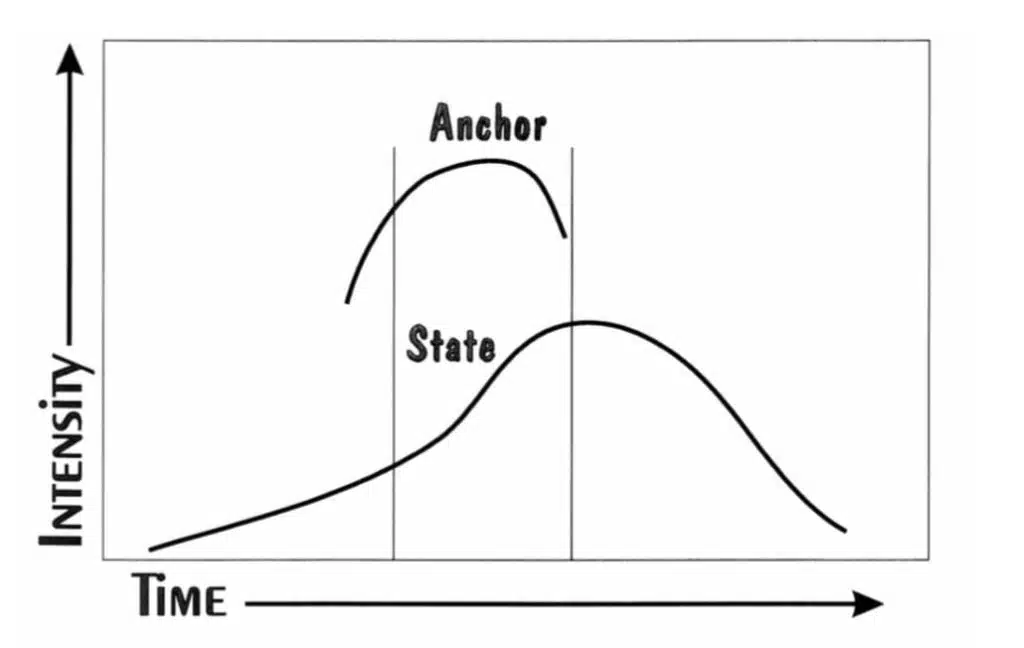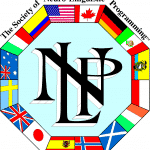

Let’s do some magic in action. Let’s provide you the secrets of NLP Anchoring. In this article you will learn all about what Anchoring is and learn about how it is discovered. Furthermore you will learn about Anchors in your Daily Life and how the Marketing Industry is using anchors to gain your interest. We will also provide some examples of Anchoring and how to utilize NLP Anchoring in your coaching practice. Last but not least you will get some exercises to ‘sharpen the sword’ and to have you bring your new learnt knowledge into action. Expand your knowledge and add it to your NLP Toolbox. Happy Reading!
Anchoring in NLP is the ability to add a specific external event to an internal experience. In example: the state of feeling good is ‘anchored’ by pressing a spot on the middle of your right hand. Does that make sense? Does that ring a bell?
Well it is easier said than done. In this article we will explain some of the techniques used and how to apply anchors. And not only that is what you will learn; you also will gain knowledge how you are ‘anchored’ by your environment.
In NLP, “anchoring” refers to the process of associating an internal response with some external or internal trigger so that the response may be quickly, and sometimes covertly, reaccessed.
Does Pavlov ring a bell? Ivan Pavlov was a Russian Physiologist who won a Nobel Prize in 1904 for his work and investigations. He did not receive the Nobel Prize for the famous research of conditioning (the Pavlov reaction), but for research on digestion.
As part of this research, he wanted to measure the saliva production of dogs when different types of food were administered. However, he came across the phenomenon that the dogs were already producing saliva even before he had given the food.
Here is in short what he did. Take a dog and put it in a blinded cage. Since his work is based on different types of food, during the experiment he administered different types of food.
Here is what he did to come to his conclusion: Ring a bell, open the hatch and give the dog some food. He repeated these steps exactly and several times. So after five or six times, he done the same procedure only slightly different. He rang a bell, opened the hatch and gave the dog no food. What happened? The dog started to drool and became grumpy. (What would you do the moment you expected food and got none?)
He came to the conclusion that there was a strong connection between ringing the bell and the dog drooling. Whilst the dog did not get any food, yet by hearing the bell, it raised its expectation to get some.
Nowadays it is called a Classic Conditioning. If stimulus (stimulus) A (the bell) repeatedly precedes stimulus B (feeding) that produces a certain behavior (response), then eventually stimulus A will produce all this response (saliva production) without stimulus B.
Imagine yourself driving a car. You are driving on a street and you approach a junction or a cross-road. There are traffic lights and they are red. What do you do? You have learned to stop and wait in front of the traffic light to have it turned green. So somewhere down the road you have learnt that when you see a red traffic light, you stop. And the moment it turns green you proceed your way. In other words, you are conditioned in this specific event.
Another example of anchoring in your daily life. You walk into a building to visit a company or a person. You walk to the elevator and press the button to go up. Then you wait for the doors to open. Once the doors open, usually guided by the elevator indicator lights flashing and a ‘bing’ sound you walk into the elevator. You press the number of the floor you need to go. Next you wait while you experience the elevator going up.
At a sudden you hear a ‘bing’ again. The elevator doors open, you walk out and come to the conclusion you are not on the right floor.
What happened? You have made a presupposition for yourself that the moment you hear ‘bing’ it must be the right floor and you have to walk out of the elevator. So in this example, the ‘bing’ of the elevator is the Stimulus to start behavior associated with that specific even: walk out of the elevator.
Many people I have trained and spoken to experienced this phenomena. So in technical terms this happens: If [A] happens, the response is [B].
Let’s start with an example for the Thai readers under us. What happens you hear the sound of the ice-cream cart? Probably now you hear the Walls tune. And of course this works two ways. Imagine you walking on the street and you hear the Walls-tune. What do you think of? Probably you think ‘Ice cream’.
If you like classical music, what happens you only hear the first part of Beethoven’s Fifth? You are able to complete it with the second part.
In the Netherlands we have a great-one that is hammered into our DNA: ‘Heerlijk, Helder, …’. For the non-Dutch people under us, we Dutch people have a strong association with this example to think about Heineken beer.
So the marketing industry utilizes the same NLP anchoring techniques to bring their product to your attention. They use a stimulus to recall behavior and to their Product. Think of Intel, they have a sound and a logo that triggers behavior.
In pricing there is another great example: You are thirsty and walk into a convenience store on a hot summer day. You are thirsty and looking for … Soda!
The sign says you can get a 20 oz Coke for $1.79 or a 32oz Coke for $1.99. For a measly 20 cents, you can get almost twice as much Coke! Now having anchored that a 20 oz Coke is worth $1.79, that 32 oz for $1.99 suddenly seems like an awesome deal! It doesn’t matter that both are overpriced.
So by studying NLP Anchoring you are able to apply the anchoring effect to how you price products or services for your business.
Working with NLP and anchoring we want to create an association, a connection, between a peak-state and having the ability to recall that state and to connect this state to future situations the client will face and experience.
When Dr. Richard Bandler and John Grinder worked on mapping the talents of Virginia Satir and Milton Erickson, they discovered that they often used word anchors to provide change for their clients.
Before we continue explaining NLP and Anchoring, you have to know something about the human Neurology. Our body is controlled by our Nervous System. Consciously and Unconsciously. So nerves are running through our body, helping us act in a way that is best.
Now, when you press with your right index-finger on your left-underarm, something happens. Besides that you are doing it yourself, something else happens.
When you press with your right index-finger on your left-underarm it is registered by your nervous system that you press. Yet what you need to know that the pressure you experience on your left underarm in this example, needs a fraction of time to be registered by your brain.
So to apply an anchor we need to work a bit on timing. Let’s explain that by the following simple graph:

Let’s say we want to anchor the Peak-State of a client with a tactile or kinesthetic anchor. We want to anchor the peak-state with the client by pressing on the lower left arm. Logically we need to discover how the client goes into a Peak-state first. Now as we have learnt that such an anchor takes a littlest of time to register with the brain, we do know that we have to apply the anchor just before the peak-state of the client.
The proof is always by eating the pudding. Now you have conditioned the client to recall the peak-state you fire off the anchor. You press the exact spot at the lower left-arm and see what is happening. Does the client go into his or her peak-state? Well done! Doesn’t it work? Or does it work a bit? Recall the peak-state of the client and reapply the anchor. We guarantee you that the moment you found your result, you will do it easier every time you do.
Sure we can. Let me state first that you play with this NLP technique in a proper manner. So to give you an example of playing around with anchors, we give you two.
Did you ever meet someone who is ticklish? They start to giggle and smile you poke your finger gently into the sides of their body. Or even worse; only by pinpointing your finger into the direction of the sides of their chest, they start to make movements. A great example of a gesture, or an external trigger, followed by an internal response.
The other example we want to give you is as follows. You like to feel good don’t you? Now imagine this. You are going to anchor the state of ‘Feeling Good’ with your client. Pick a decent spot on your client’s arm. Bring him or her in the state of feeling good and anchor it. Test the anchor and once it works, you trigger the anchor and the client goes into the state of ‘Feeling Good’ your first part of this example is successful. Now comes the ‘Playing with Anchors’ part.
As you already have learnt about Hypnotic language, you have studied the Milton Model right? We add in a bit of change. You already know the power of language patterns like “The more you feel Good, the more you become relaxed and self-assured and the more you become self-assured and relaxed the more you feel good.” So in other words you bind several great states together as an infinite loop of reinforcing states. Feeling good leads to being relaxed and self-assured that need to feeling good even more.
And while you fire-off this anchor you have set previously, you provide the sentence above to your client while moving your finger up over the client’s arm. In technical terms we call this a Sliding Anchor. Fun right? It takes a bit of practice, yet our experience is that once you found your way of working, it is so much fun to do. Imagine you making a person feel good for no reason.
Before you deep-dive into the exercises below, remind yourself that when you start small, you have a reference that works, you easily can extend it. So our suggestion is to start small and then start to add up and add in more details. Expand the experiences with NLP Anchoring that work and rework the experiences that give less outcome. We want you to be succesful!
First an exercise to learn to recognize them. You love to watch television right? So you do know the annoying advertisements that come with watching television. Well this annoying part is what this exercise is all about. Watch a few advertisements and learn to recognize what they are binding together and which feeling they are creating. Washing detergent commercials will tie white and bright together with a bright living and healthy people. Car commercials will map status and freedom and intelligence together buying that specific brand. Learn to recognize what anchors they are setting.
Next exercise you do by observing your environment. Let’s say you are at the railway station and you observe how people act in entering and leaving the train. Basically, this observation exercises is a very good one to embed in your routine. You are able to apply the knowledge of this article and NLP Anchoring in specific everywhere!
The last exercise to amuse you and set you on the right track; Work with another person where you start to apply your knowledge of anchoring and give that person a great feeling. As you already recall, we gave you plenty of input in the examples of anchoring earlier in this article.
Remember that there is a lot more to tell and say about NLP Anchoring, when and how to use it, good practices, bad practices and so on. The above article is intended to get you thinking and maybe exercising and validating the information you have learnt. There is a lot more to tell about Anchoring. For example that we did not cover in this article is Collapsing Anchors and how to utilize anchors in your trance or hypnosis sessions.
Remind yourself to apply all the techniques we already have described here; maintain Rapport, read eye-accessing cues, use the Meta Model to reveal hidden information from your client.
In our NLP Practitioner Training and NLP Master Practitioner Training we will learn you how to setup Anchors, how to utilize them and how to apply them in your business and daily life. You will learn practical examples you directly are able to apply to enhance your life. You learn how to setup Visual, Auditory and Kinesthetic anchors. Imagine now, you working on your Personal Development at peak-state attending our NLP Practitioner Program.
Mind Tools provides NLP Practitioner and NLP Master Practitioner Trainings and Certifications. We educate you according to the renowned, latest and highest standards set by the Society of NLP. We will train you thoroughly in all the corners of Neuro-Linguistic Programming and some extras we learned from Richard Bandler directly.

Our NLP Practitioner Training starts in:
On Checkout use the code NLP10PCTOFF and gain an extra 10% off our already discounted price.